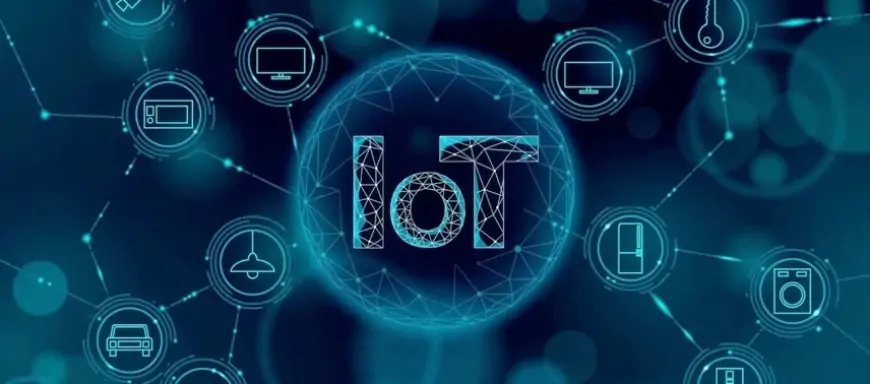What is the Internet of Things (IoT)? Exploring its impact and potential
Discover its impact and potential as everyday devices connect to the internet, transforming how we interact and operate.

The Internet of Things (IoT) has emerged as a revolutionary technology over the last decade, revolutionizing both smart homes and smart offices. By 2024, the global IoT market is projected to achieve an impressive revenue of $1,387.00 billion. But what exactly is IoT, and why has it captured such widespread attention?
Understanding the Internet of Things (IoT)
The Internet of Things, abbreviated as IoT, refers to a network of devices capable of connecting to the internet and sharing data with other IoT devices and centralized cloud servers.
IoT devices encompass a wide range of internet-connected digital appliances, including virtual home assistants, smartwatches, wearables, drones, lights, baby monitors, and home appliances.
Well-known consumer examples of IoT devices include Amazon Alexa, Google Home, Apple Watch, and Ring. As of 2024, Statista reports there are 17.08 billion connected IoT devices globally.
How do IoT devices work?
Numerous IoT devices employ physical sensors to gather data from their surroundings and can be remotely controlled by users. For instance, IoT-enabled lighting systems can assess local light brightness and adjust it based on user preferences.
These devices transmit locally collected data to an IoT gateway, a central hub that forwards this information to a cloud server for processing via a Software-as-a-Service (SaaS) application. For instance, a logistics company might utilize a data analytics application to monitor timely order fulfillment rates.
Why IoT holds significance?
The importance of IoT lies in its transformative capabilities across consumer and enterprise sectors.
In home environments, consumers utilize IoT-enabled devices to remotely control home settings like lighting, temperature, appliances, entertainment systems, security cameras, garage doors, and even monitor health metrics via smartwatches.
In business environments, IoT is crucial for several reasons:
- Data collection: IoT devices enable organizations to gather and analyze data from decentralized devices. This data provides valuable insights into operational processes, optimizing decision-making by identifying areas for enhancement such as real-time stock monitoring and equipment maintenance alerts.
- Task automation: IoT facilitates automation of manual tasks and remote interaction with infrastructure. This automation streamlines operations, allowing human resources to focus on more strategic responsibilities. For instance, IoT-enabled stock monitoring eliminates the need for manual stock checks by providing centralized, accessible data.
- Cost reduction: By improving efficiency through real-time data collection and analysis, IoT helps organizations reduce operational costs over time. Enhanced efficiency allows businesses to optimize resource allocation and improve overall cost-effectiveness.
In summary, IoT empowers both consumers and businesses by enhancing control, automation, and operational efficiency, thereby driving significant benefits in productivity and cost management.
Pros and cons of IoT
There are several important advantages and disadvantages to consider when adopting IoT technology:
Pros
- Gathering data from multiple devices for analysis and insights
- Enabling remote operation and management of processes
- Continuously enhancing operational efficiency
- Facilitating improved decision-making processes
- Remote monitoring and management of assets and resources
- Enhancing predictive maintenance and trend forecasting
- Introducing new revenue streams through product-as-a-service models
- Improving employee safety by monitoring conditions in hazardous environments
Cons
- Dependence on stable internet connectivity for IoT devices
- Challenges in integrating devices from different manufacturers
- Complexities in maintaining and managing IoT devices
- Need for robust security measures to protect against cyber threats
- Requirement for training employees on IoT device usage
Technologies enabling IoT
Several technologies support the functionality of IoT devices:
- Sensors: IoT devices utilize sensors and actuators to detect changes in their environment, such as heat, humidity, light, or pressure.
- Communication technologies: IoT devices use various communication protocols like Wi-Fi and Bluetooth to interact and share data with each other and with cloud services.
- Cloud computing: The cloud serves as the central hub for IoT networks, where data collected by devices is stored, processed, and accessed by users.
- Big data analytics: This technology plays a crucial role in analyzing the vast amounts of data generated by IoT devices, helping users uncover patterns and gain insights.
- Artificial intelligence: AI technologies, such as natural language processing (NLP), are integrated into devices like Alexa and Google Home, enabling them to understand and respond to user commands and queries locally on IoT devices.
In summary, IoT devices can revolutionize interactions for both consumers and businesses within their local environments. By linking everyday devices to the internet, users gain access to valuable insights, data, and interactions that were previously unavailable in traditional IT setups. Real-time oversight and management of devices enhance consumer experiences and optimize organizational efficiency, presenting ample opportunities for growth and ongoing enhancement.












































